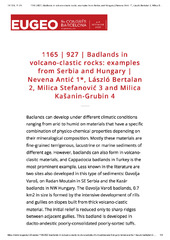| dc.creator | Antić, Nevena | |
| dc.creator | Bertalan, László | |
| dc.creator | Stefanović, Milica | |
| dc.creator | Kašanin-Grubin, Milica | |
| dc.date.accessioned | 2024-01-18T14:05:18Z | |
| dc.date.available | 2024-01-18T14:05:18Z | |
| dc.date.issued | 2023 | |
| dc.identifier.uri | http://TechnoRep.tmf.bg.ac.rs/handle/123456789/7138 | |
| dc.description.abstract | Badlands can develop under different climatic conditions ranging from arid to humid on materials that have a specific combination of physico-chemical properties depending on their mineralogical composition. Mostly these materials are fine-grained terrigenous, lacustrine or marine sediments of different age. However, badlands can also form in volcano-clasitc materials, and Cappadocia badlands in Turkey is the most prominent example. Less known in the literature are two sites also developed in this type of sediments: Đavolja Varoš, on Radan Moutain in SE Serbia and the Kazár badlands in NW Hungary. The Đavolja Varoš badlands, 0.7 km2 in size is formed by the intensive development of rills and gullies on slopes built from thick volcano-clastic material. The initial relief is reduced only to sharp ridges between adjacent gullies. This badland is developed in dacito-andesitic poorly-consolidated poorly-sorted tuffs. The weathering processes are intense and governed by high intensity precipitation and prolonged drying periods. The reddish earth pyramids built of these erodible materials are protected by the cap rock. Loss of balance and fall of the protective cap rock accelerates the erosion. The smaller Kazár badlands covering the area of 1ha are developed in rhyolitic poorly-consolidated highly porous tuffs. Rills and gullies are the dominant geomorphic processes and the weathering is dominated by freeze-thaw processes. At the Kazár badlands earth pyramids are not protected with the cap rock and weathering, disintegration and sheet wash erosion intensively shape the landscape. Although the materials differ slightly in composition, both being poorly sorted, clay-size rich materials make them sensitive to erosion, proving once more the importance of material composition, in this case namely grain size including sorting and mineralogical composition, for badlands development and future evolution. | sr |
| dc.language.iso | en | sr |
| dc.rights | openAccess | sr |
| dc.rights.uri | https://creativecommons.org/licenses/by/4.0/ | |
| dc.source | 9th EUGEO Congress, Barcelona 4-7 September 2023 | sr |
| dc.title | Badlands involcano-clastic rocks: examplesfrom Serbia and Hungary | sr |
| dc.type | conferenceObject | sr |
| dc.rights.license | BY | sr |
| dc.citation.spage | 927 | |
| dc.identifier.fulltext | http://TechnoRep.tmf.bg.ac.rs/bitstream/id/19669/Abstract_927.pdf | |
| dc.identifier.rcub | https://hdl.handle.net/21.15107/rcub_technorep_7138 | |
| dc.type.version | publishedVersion | sr |

